THIS BROKEN RAILROAD
By its nature, Call of the Netherdeep is a linear campaign: Festival of Merit → Emerald Grotto → Bazzoxan → Ank’Harel → Cael Morrow → the Netherdeep.
In theory, this should be fine.
In practice, however, the designers have decided to link these set pieces together with a railroad.
And, unfortunately, it’s a really shoddy railroad. Honestly, just sloppy, terrible, ill-conceived infrastructure. Maybe not quite, “there’s a dragon attacking a town that’s also being besieged by an army, and our expectation is that the 1st level characters will decide to just walk into town,” bad, but close.
Let’s start with the hook for the entire campaign.
At the end of the Festival of Merit, the Elders of Jigow choose the two most successful teams to compete in the Grand Finale race through the Emerald Grotto. One team will be the PCs. The other team will be the Rivals.
This is a little weird, because literally none of the festival games up to this point have been team-based events. The only previous mentions of a “team,” in fact, were (a) an event where you are explicitly FORBIDDEN from competing as a team and (b) a different event where you competed with a partner (which is not the same thing as the five-ish person teams selected at the Grand Finale).
So, to kick things off, there this’s big, glaring continuity error squatting right on top of the event which is the lynchpin for the entire campaign.
In any case, the PCs and Rivals have to race through the Emerald Grotto and claim the Emerald Eye. Whichever team returns with the Emerald Eye wins the race.
Oddly, the adventure then acts as if the races ends as soon as someone grabs the Eye. Which, of course, it doesn’t.
But let’s move past that, too.
The real problem here is that the entire campaign hook is horribly broken.
Here’s how it works:
- The PCs get to the end of the Emerald Grotto and they spot a shark that has the Emerald Eye strapped to its side.
- They fight the shark.
- When the shark dies, it crashes into a stone pillar, causing the wall of the cavern to crack open.
- This reveals a passage “awash with golden light.”
- If the PCs go down the passage, they will discover the Jewel of Three Prayers, which — as noted above — is the essential McGuffin on which the entire plot is built.
Problem #1: It’s a race.
So, yeah, the glowy light is interesting. But the PCs are motivated by their immediate and only goal to NOT explore the light right now. Generally speaking, you want scenario-crucial actions to flow from the established goals of the PCs, not in direct contradiction to them.
The same is true of the Rivals, of course, but ultimately you, as the DM, control their actions, so you can just decree that they go and check out the glowy light even if the PCs don’t. The campaign is designed to hypothetically work if the Rivals claim the Jewel of Three Prayers (more on that in a second), so you can route around this. It’s just kind of awkward in its design.
The bigger problem is that you don’t have to fight the shark.
In fact, fighting the shark is probably the dumbest way for the PCs to get the Emerald Eye.
Even if you overrule an Animal Handling check, that still leaves alternative solutions like mage hand (to grab the amulet), an animal friendship spell, or just a Stealth check (with or without invisibility). And it should be noted that the writers know that these options exist, because animal friendship is how they get the amulet on the shark in the first place:
A druid of Jigow cast animal friendship on the shark earlier today and tied the Emerald Eye around its body, then made a speedy getaway.
So… no dead shark?
No thrashing.
No thrashing, no pillar collapse.
No pillar collapse, no glowy light.
No glowy light, the campaign doesn’t happen.
Oof.
Okay, let’s move forward to the next day. There are four scenarios:
PCs have the Jewel, the Rivals are Indifferent. The Rivals decide to just follow the PCs. (We’ll come back to this.)
PCs have the Jewel, the Rivals are Friendly. The Rivals offer to join the PCs (and, as mentioned before, the rivalry breaks and GMPC problems start).
PCs have the Jewel, the Rivals are Hostile. In this case, the Rivals try to steal the Jewel. First, as mentioned earlier, this probably means that the Rivals are now dead and the rivalry is over. More than that, the railroad is frequently driven by the Rivals showing up by surprise and forcing the plot forward: So whether they’re working with the PCs or they’re dead, the railroad breaks multiple times over.
Second, their plan for stealing the Jewel is also hilarious:
The rivals’ plan is to gather outside the inn where the characters are staying. One rival then sneaks into the characters’ room at the inn and searches for the jewel. If the thief doesn’t return after an hour, the rivals travel to the Emerald Loop Caravan Shop (described later in this chapter) and wait up to seven days for their mission companion.
Uhh…
Maggie: So the plan was for Galsariad to sneak in and grab the Jewel?
Ayo: Yup.
Maggie: And then he comes right back?
Ayo: Yup.
Maggie: And he hasn’t come back.
Ayo: Yup.
Irvan: What should we do?
Ayo: Let’s leave town and wait at a rest stop for a week. See if he shows up.
…
Anyway.
The Rivals have the Jewel. This is, as both we and Call of the Netherdeep have established, quite likely. And if it happens, the railroad junction is almost unimaginably bad:
You’re eating breakfast at the Unbroken Tusk while locals chat around you. Through the cacophony, one voice catches your attention.
“Rumor has it they’re going to Rosohna to sell it. Elder Ushru met them and everything, kept whispering while pointing at a huge, shiny amulet on the table. He was talking about ‘destiny’ and other heroic-like words. I think they were the group who won the grand finale yesterday. The amulet looked plenty magical, but even if it isn’t, it’d be worth a fortune. Yeah, they’re traveling down the Emerald Loop today.”
[…]
People are saying that the jewel would sell for over 1,000 gold pieces — maybe twice that if it’s magical, and twice that again if the sellers were to make the long, oversea journey to a trade hub like the desert metropolis of Ank’Harel.
Nothing is forcing the characters to chase down the rivals, but the thought of losing out on such a prize is enough to motivate most adventurers.
That’s it. That’s the hook: Chase the Rivals down and rob them.
“The thought of losing out on such a prize is enough to motivate most adventurers.”
That’s not adventurers. You’re thinking of criminals.
And not even very smart criminals. There’s gotta be easier marks for 1,000 gp than five well-equipped adventurers who already beat you once.
Even if the players do hear these rumors and leap straight to, “Oh, man! We definitely gotta rob those people!” Call of the Netherdeep forgets to include a mechanism for telling them that they’re supposed to go to Bazzoxan.
Sure, they might interrogate the Rivals before/after robbing them. Or maybe they follow them all the way to Bazzoxan before robbing them.
But if not, the entire adventure is literally scripted to derail.
EVERYTHING FAILS TOGETHER
Sadly, the whole campaign is like this. Every transition is a broken, ill-conceived railroad.
One I want to call particular attention to, however, is the transition from Bazzoxan to Ank’Harel, because I think it reveals the fundamental misstep of Call of the Netherdeep here.
To briefly review, the core structure here is:
- The PCs meet one or more of the three researchers in Bazzoxan.
- They go into Betrayers’ Rise.
- They follow one of the researchers back to Bazzoxan, where they join that researcher’s faction.
This seems pretty straightforward, right?
But every step of the way, Call of the Netherdeep transforms this into a tortured disaster.
First, the campaign hides the researchers so that the PCs have to jump through weird, arbitrary, unlabeled hoops to meet them.
The first option is:
- The PCs randomly wander over to the crematorium.
- They decide to stay and help dispose of corpses.
- A researcher named Prolix shows up.
If the PCs don’t go to the crematorium? The campaign breaks. If they don’t help dispose of the corpses? The campaign breaks.
The second option is:
- The PCs eventually wander into the inn.
- Among a number of other patrons, there’s a tiefling in the common room.
- If they don’t talk to the tiefling, the adventure specifically says the tiefling will ignore them.
- If they do talk to the tiefling (who is named Question), they need to mention the Jewel of the Three Prayers.
- If they mention the Jewel, then the third researcher (Aloysia), who has been eavesdropping on this conversation, will be like, “Hey! I’m the NPC who tells you what to do next!”
Don’t randomly talk to the tiefling? The campaign breaks. Don’t decide to spontaneously mention the Jewel (which you could very easily have decided is something you shouldn’t be flashing around) during this specific conversation? The campaign breaks.
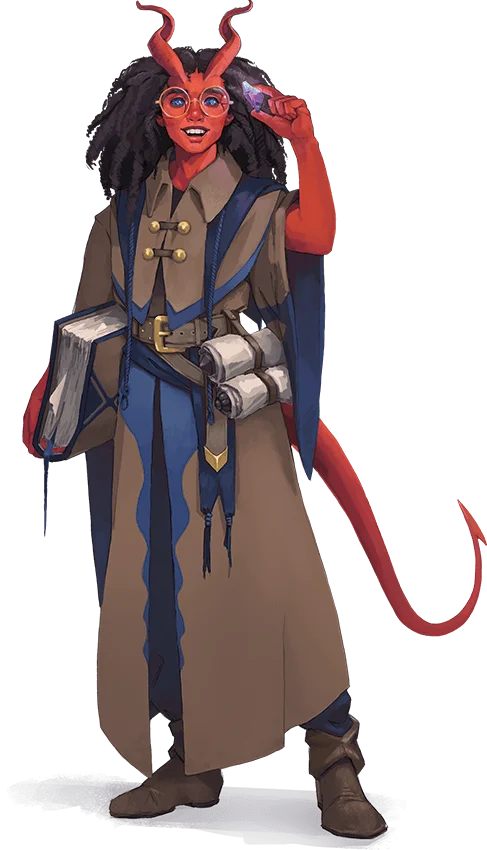 This is, to put it politely, a very convoluted path. It’s really unclear to me why they’re locked the plot behind these deliberately obfuscated checkpoints.
This is, to put it politely, a very convoluted path. It’s really unclear to me why they’re locked the plot behind these deliberately obfuscated checkpoints.
To put it less politely, this is video game writing. And, sure, in a video game you can expect the players to keep clicking on NPCs in the tavern until they click on the right tiefling. But it doesn’t translate to the table top at all. There is no display of patrons for the players to click on.
But we’re not done yet.
Aloysia then proposes that she and the PCs should work together. Of course, as we’ve established, the campaign then just assumes the PCs will not accept her offer and pretends it never happened.
The campaign is simultaneously pretending that there’s no way the PCs are working with the Rivals, either. This is important, because, at the end of Betrayers’ Rise, the designers frame up a heavily railroaded “gotcha!” scene where Aloysia, accompanied by the Rivals, shows up and steals the Jewel.
This forced fight (which can’t happen at all if any of these convoluted preconditions is not met), ends with one of two scripted outcomes.
If Aloysia wins, she cracks a teleportation tablet, creating a teleportation circle to Ank’Harel, and announces that the Rivals should follow her. The PCs theoretically have the opportunity to follow her here, but since they’re presumably dead or unconscious, this is unlikely.
If Aloysia loses, she runs away and casts earthquake, triggering a cave-in that blocks the PCs from pursuing her. She then fumbles through her bag and — hilariously — drops two teleportation tablets on the ground while trying to activate a third.
The PCs can then spend 10-20 hours digging their way out, find the teleportation tablets, think to themselves, “This definitely isn’t a trap,” and then use them to follow her.
Now, once the PCs get to Ank’Harel, the book acts as if the PCs are equally likely to join each of the three factions. But that’s not really the case, is it? First, Aloysia has just tried to rob them (and possibly kill them). Remember the Unforgivable Sin of stealing the PCs’ shit? Yeah.
Second, the only way for the PCs to join Aloysia’s faction — the Consortium — is if they raced after her, jumped through the teleportation circle moments after she went through, immediately forgave her for everything, and then signed up on the spot.
I mean… C’mon. Even if the adventure wasn’t doing everything in its power to stop the PCs from doing that, it’s not exactly a plausible outcome, right? “Hey, person who just tried to kill us! We are interested in your ideas and would like to hear more! Do you have a pamphlet or anything we could look over?”
It seems fairly likely to me that all of this would have made a lot more sense earlier in development: You have dynamic, interesting Rivals. The researchers in Bazzoxan would have had clear, ruidium-focused agendas. This would allow the players to make meaningful choices about which faction’s agenda they agree with, and these choices could have been contrasted against the choices of the Rivals, driving the action forward through Bazzoxan and into Ank’Harel.
If the book just presented these as toys for the DM to actively play with, it’s a robust situation rich with possibility.
But then somebody decided that they needed to write a railroad that forces Aloysia to be a maniacal, monologuing villain.
And the whole thing falls apart into nonsense.
The researchers get hidden behind scripted cut scenes in Bazzoxan. The adventure wants to hide what the researchers know (so that there can be Startling Revelations™ in Ank’Harel), so the PCs aren’t given the information to make meaningful choices. Aloysia gets railroaded off the table as a viable ally.
No clear stakes? The choice of researcher becomes arbitrary.
No true choice in researchers? The faction recruitment in Ank’Harel breaks.
All of these threads — all of these broken techniques based on the fundamental flaw of believing that railroading is the only way to link an adventure together — are woven together here. The result is muddy, confusing, difficult to use, and, more often than not, completely broken in actual practice.
It’s easy to look at a moment like this and say, “Well, the writers can’t possibly account for every possibility!”
And you’d be right.
Which is why Call of the Netherdeep SHOULD be focusing on giving the DM — who CAN account for what the group has done — the tools to do so, rather than hamstringing them with unusable scripts.
FACTION MISSIONS
In addition to the shortcomings of Netherdeep’s connective tissue, we now need to talk about the faction missions in Ank’Harel.
Like the faction missions in Dragon Heist, these are very barebones in their presentation.
Unlike the faction missions in Dragon Heist, these aren’t designed to be run as contrapuntal story beats while other stuff is happening. They’re just a linear string of events. So the barebones approach here mostly just means that this phase of the campaign feels incomplete.
The other problem with the faction missions is that… well, they’re pretty bad.
For example, there’s a mission where someone is trying to frame one of the PCs’ friends for stealing a ring by planting it in his pocket. So the PCs mount an investigation to clear their friend’s name.
They find two pieces of evidence:
- An Insight check reveals that someone has a “guarded expression.”
- This same person, a researcher in the ruidium-infested ruins of Cael Morrow, has a ruidium infection.
The adventure then confidently announces: “The characters can present their findings to Headmaster Gryz Alakritos.”
…
WHAT findings?
Bizarrely, their NPC friend, whose name they “cleared,” then gives them the ring as a reward.
The stolen ring.
That isn’t his.
Because that was the whole premise of the entire scenario.
The next faction mission features the PCs needing to track down a double agent. This one wraps up when the PCs find two pieces of evidence:
- An Insight check reveals the agent’s “true intentions and affiliation.”
- This same person, a researcher in the ruidium-infested ruins of Cael Morrow, has a ruidium infection.
And if you’re thinking, “Justin, you just said that.”
Yes.
Yes, I did.
It’s the exact same setup.
And the conclusion is, once again, “Proof?! Sir, I made an INSIGHT check!”
Add to this the aforementioned problem of multiple faction missions being set in the ruins of Cael Morrow, despite Cael Morrow being too small to support multiple faction missions.
Basically, the faction missions are really bad.
Fortunately, they’re also pointless: The idea is that you have to do these faction missions in order to gain access to Cael Morrow. But it turns out that the impregnable security on the Cael Morrow site consists of… a handful of CR 1 guards who might summon five CR 3 guards if they get a chance.
CONCLUSION
I’ve spent the last couple of sections really breaking down the problems with Call of the Netherdeep, so as we wrap up, I want to mention a few more things that I really like about the book.
First, the monster design is fantastic. Look at this aboleth spawn, it oozes creepiness:
And look at this sword wraith:
Just incredible concepts wedded to fantastic art. In fact, as you’ve seen throughout this review, the art team for Call of the Netherdeep is simply superb from one end of the book to the other.
Speaking of the visual design, I also want to mention the ruidium-inspired design of the book. At the beginning of the campaign, the occasional page will have have a ruidium-veined edge treatment. Over the course of the book, however, these veins grow, until the ruidium appears to be literally taking over the tome.
I don’t know if that’s the work of Senior Graphic Designer Trish Yochum or Graphic Designer Matt Cole, or both, but bravo. Excellent work.
In closing, as I look over the totality of Call of the Netherdeep, I see some familiar themes and elements:
- Faction missions from Dragon Heist
- Corrupting crystals from Legacy of the Crystal Shard
- A three-stage god fight like the one found in Rime of the Frostmaiden
- Deep-diving memory visions to redeem a divinity from Descent Into Avernus
But the synthesis works here. In fact, in all but one case (the faction missions), I think you can safely argue that each individual element works better in Call of the Netherdeep than in its antecedents.
I think there are, as we have seen, some serious issues with structure and logic that will make this campaign much harder to run effectively than it should be. Ultimately, whether you decide to answer the Call of the Netherdeep or not is largely going to depend on whether you think it’s worth the salvage effort to rebuild the core structure of the campaign into something that makes sense.
The things to focus on, I think, are:
- Those excellent dungeons that form big, meaty pillars to build your campaign around.
- The fundamental excellence of the Rivals once your strip away the badly scripted sequences.
- The beautiful and enigmatic lore of Alyxion the Apotheon, which — if properly structured — will draw the players deep into a tragic story of epic proportions and then empower them to provide its conclusion.
Despite my reservations, I recommend Call of the Netherdeep. With a manageable amount of work, I think you’ll find something truly special for you and your players to enjoy.
Style: 5
Substance: 3
Project Leads: James J. Haeck, Matthew Mercer, Christopher Perkins
Writers: James J. Haeck, Makenzie De Armas, LaTia Jacquise, Cassandra Khaw, Sadie Lowry
Publisher: Wizards of the Coast
Cost: $49.95
Page Count: 224
FURTHER READING
Call of the Netherdeep: Running Betrayers’ Rise
Call of the Netherdeep: Running the Rivals
Remixing Call of the Netherdeep
How to Remix an Adventure

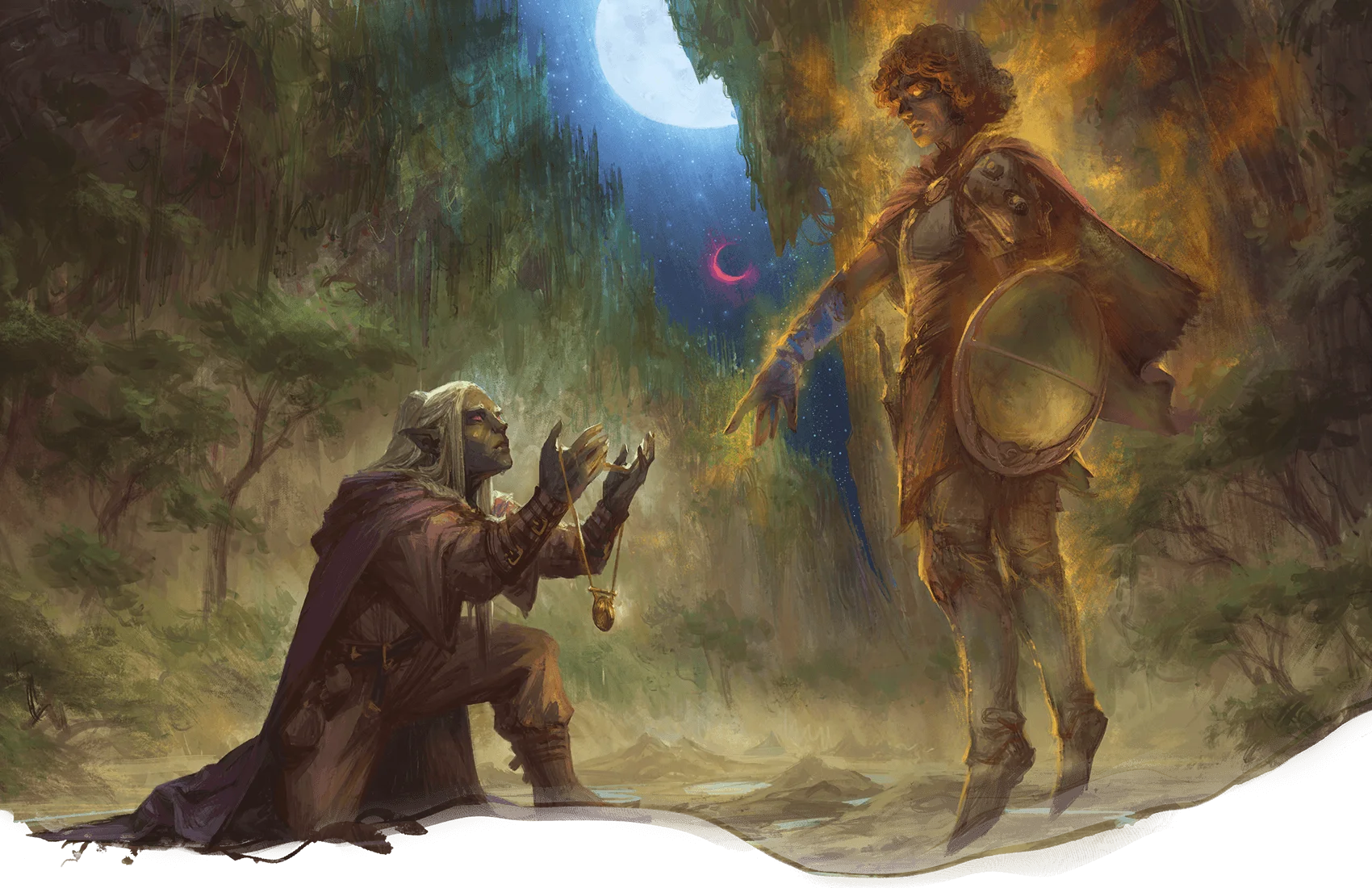
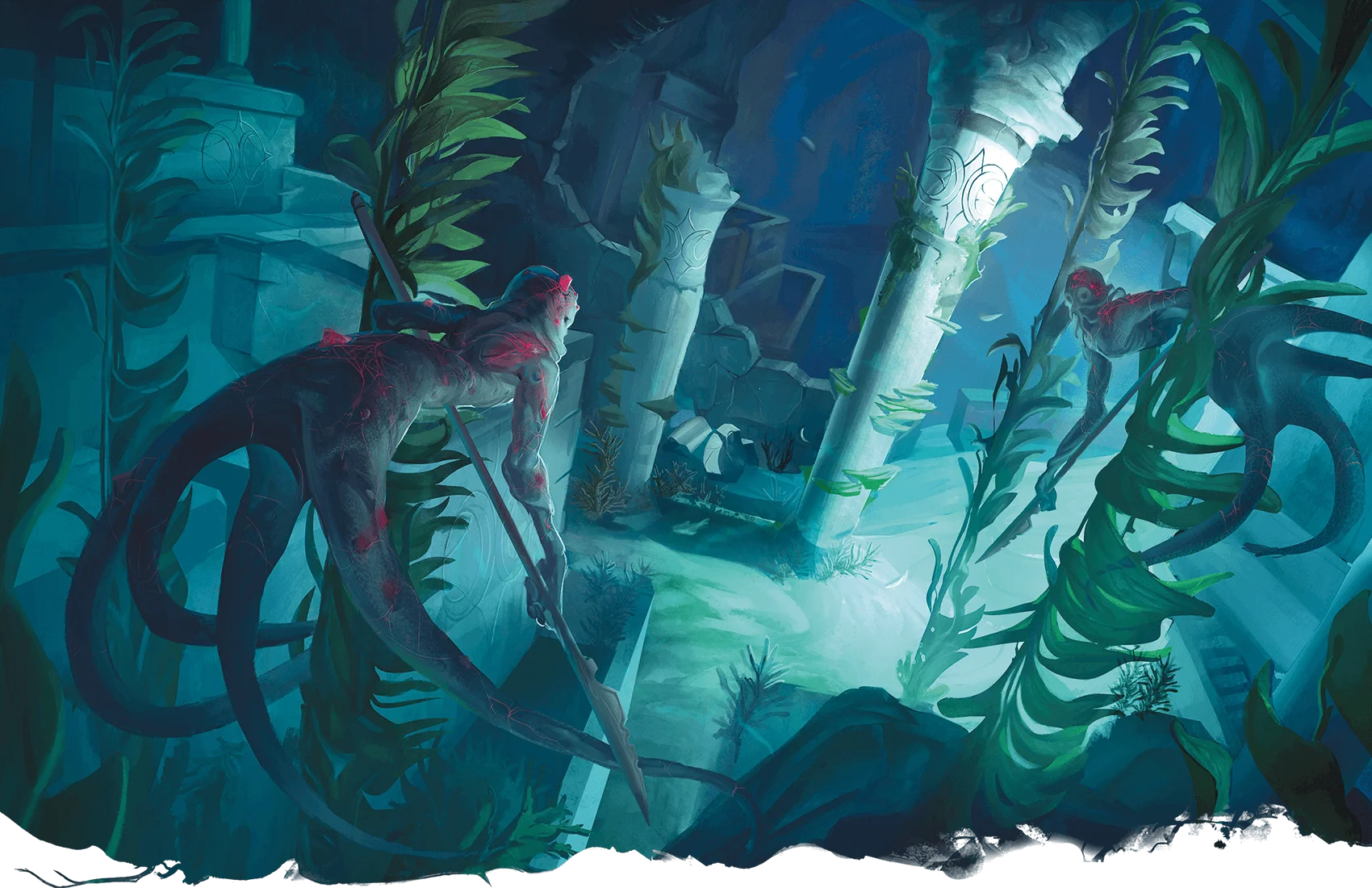
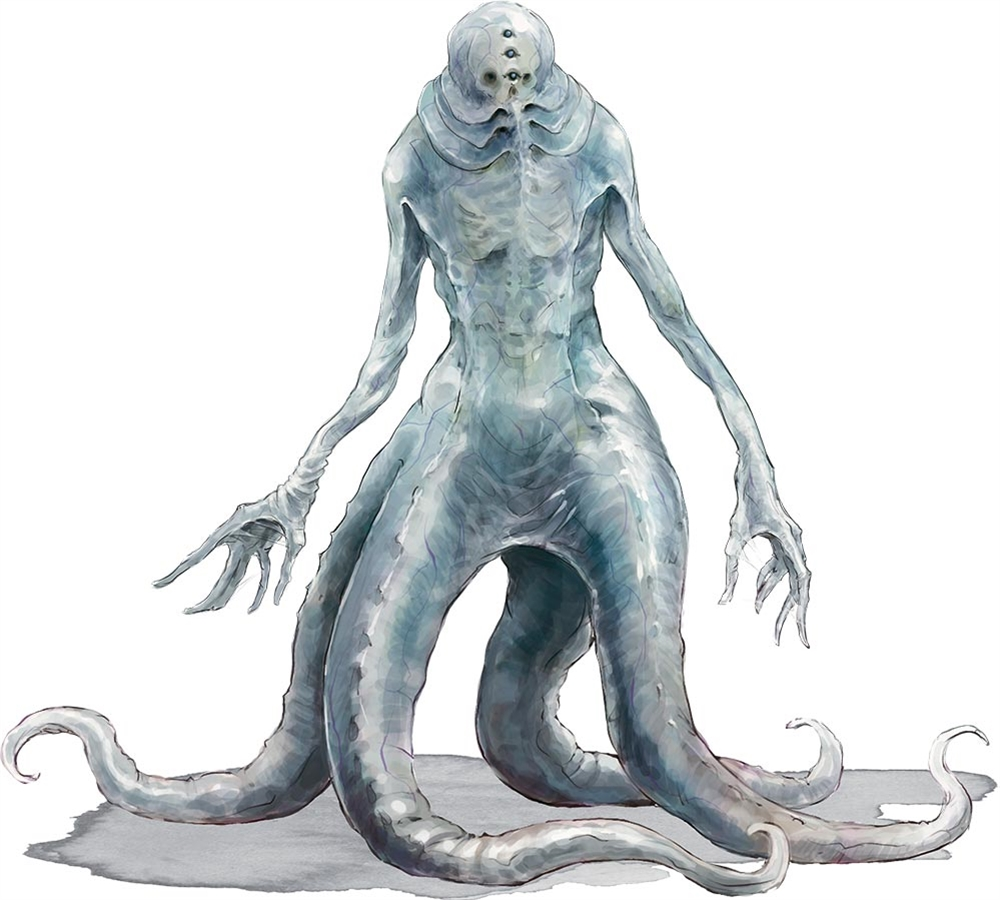
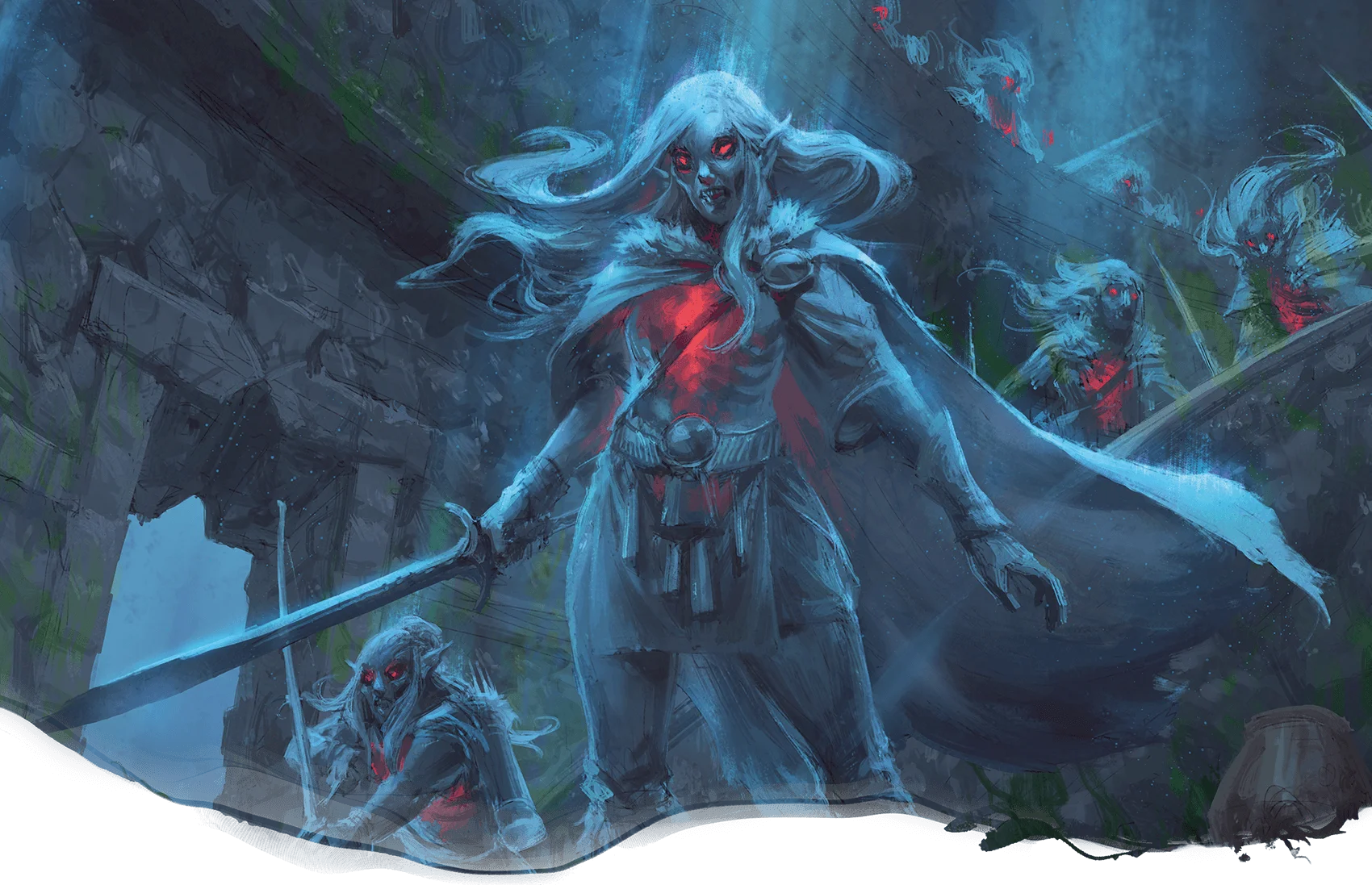
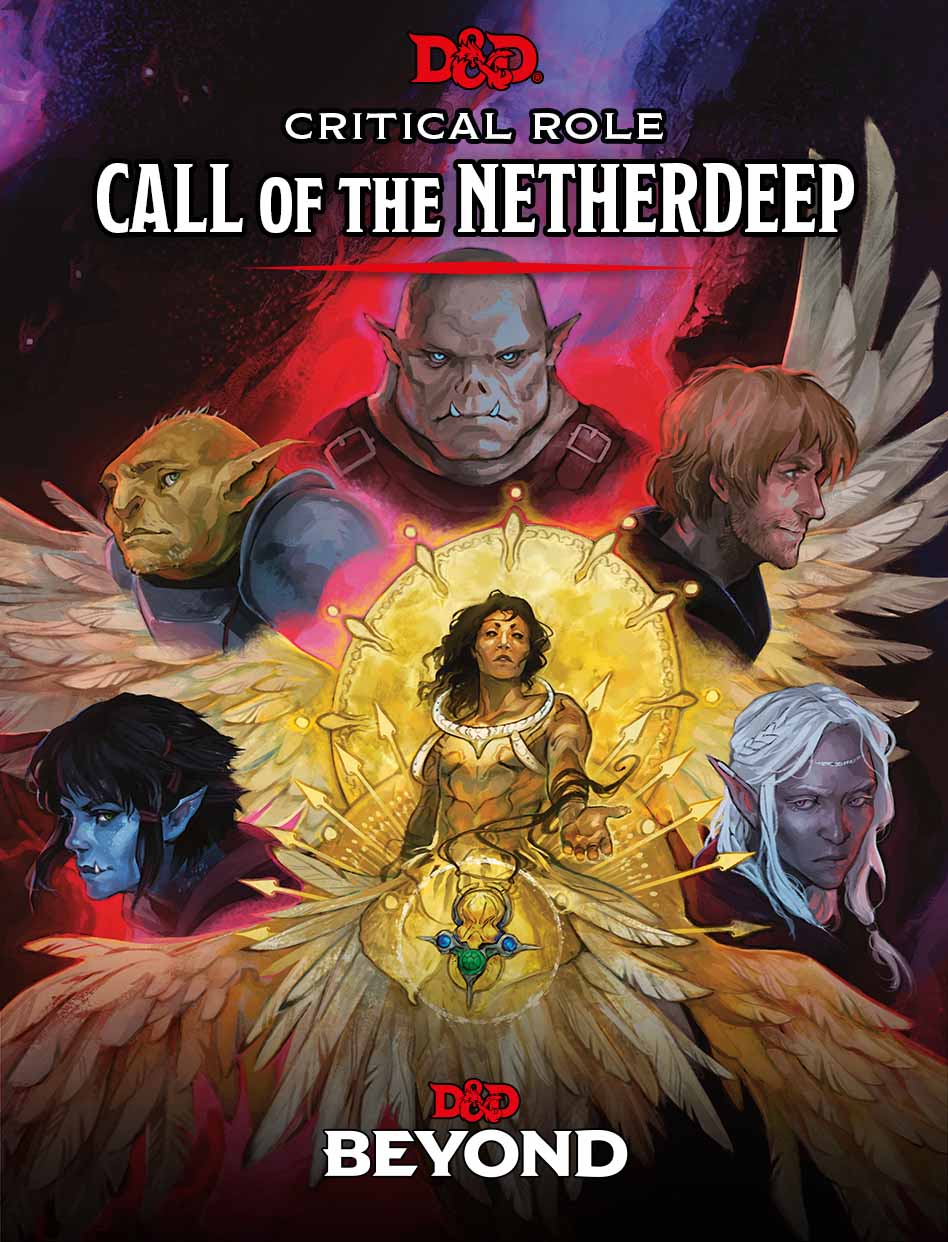











I think it’s weird that Chris still has a job, much less is chief designer over there. It seems that there is a direct correlation between his involvement in a module, sourcebook, etc and its broken-ness.
Am I missing something?
It sounds like Netherdeep might be a decent candidate for a Remix, though certainly not to the level of Descent or Dragon Heist.
Regarding the research groups, the key is probably to present them as equally viable options with differing alignment biases, and make it so that any of them can come to steal the Jewel in the Rise, not just Aloysia.
The Rivals are, generally speaking, an okay bunch, so I think at least their behavior should be defined in opposition to the Party- tending towards friendly and opposing them as misguided if the PCs lean good, viewing them as up-and-coming villains if the PCs lean evil.
Honestly, it sounds more like if they moved some of the revelations around and gave more broad hooks, it would work.
For example, they could easily “three clues” the jewel in the Festival. They already have one way to find it – the shark smashes it open if it’s killed. You could also have a perception check to notice a glow and suggest there’s treasure behind the wall (powerful magical aura if they use Detect Magic) and a crack that suggests they can smash it open, and maybe have a rumor early on in the festival that there was a hidden treasure in the ruins that was never found. The rivals finding it acts as a “fail forward”.
For other hooks:
– If the PC’s don’t get the Jewel of Three Prayers maybe a researcher on his/her way to Bazzoxan contracts them as bodyguards. Keep the rumors about the jewel, but those just act as a bonus hook or a “repetition” so the players are primed for when the jewel is revealed as a mcguffin.
– You can replace a lot of the hooks that require the players do something specific like staying to burn corpses or talking to an NPC that ignores them with “Nodes that seek out the players” – the Researchers go out of their way to seek out the players (say, because they need “muscle” to clear out places that are trapped or infested to do their research, or because they heard a rumor that they have the Jewel). These are all hooks that can be dropped on the players at the start or end of the session when they’re at the tavern.
– Instead of having Aloysia randomly drop teleportation tablets, have her drop a letter that mentions how important the jewels are to the operations at Ankh’Harel. This is a good opportunity for a bit of exposition. Players will either pursue her to get the jewel back if she steals it, or to further the plot if the value of the jewels is well known to them.
– Also, to make her faction less unappealing, have the players show up to a superior (make one up if you have to) scolding her for stealing the jewel instead of trying to work with the PC’s. And have that superior give the players something as an apology – gold or consumables should do.
– To deal with the rivals possibly joining the PC’s… just don’t have them do that. Reward the players in other ways for working with the rivals, like having the rivals give them clues (“We hit a few trapped statues on our last delve, might want to double check.”) on jobs or having them deal with side problems in ways that are obvious (say, reinforcements don’t show up for a miniboss, and they’re clearly killed with weapons the rivals use).
It seems like it’s not nearly as broken as some of the other ones.
“It seems like it’s not nearly as broken as some of the other ones.”
Is it just me or is it really sad that that’s actually high praise for a 5e campaign? It seems to be a pipe dream to get a book from Wizards that isn’t any better than “man, this needs a ton of of work but once you put the hours in, it’s sort of okay.”
i really enjoy reading your stuff. the very clear very straightforward breakdown of how events actually effect each other vs your expectations is also how shamus going writes. I know I’ll ve rereading this just for the sheer pleasure
Just a quick point, neither of the monsters above were designed for this book 🙁 The aboleth-spawn is the same art used for a Skum in “Saltmarsh” (potayto-potahto) and the sword wraiths are from Volo’s (although the art is new).
You shouldn’t run it as a railroad if you don’t like linear campaigns. Run it with explorer’s guide to Wildemount and the Brass dragon section from Fizban’s.